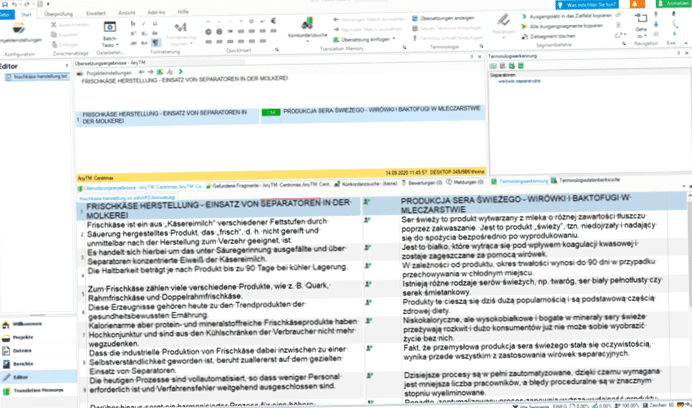Please do not confuse: there are people who confuse the use of CAT tools with machine translation. A maschninal translation (MT) is automatic, i.e. without the intervention of a human translator. CAT tools, on the other hand, merely support the translator in his or her work, which is why they are referred to as “computer-assisted translation”. The abbreviation CAT stands for computer-aided translation or. computer-assisted translation.
Components of a CAT tool
Probably the most crucial components of a CAT tool are the translation memory system (TM or TMS) and the terminology database.
- Translation Memory System: The TM is a translator’s personal translation memory. Everything you have translated so far is stored in this system in a structured way. On the one hand, it serves as a kind of reference book in which the translator can search for translations made, and on the other hand, the program uses the translation memory to search for phrases with a given minimum match and offer them as translations. The suggestions can then be accepted, adapted or rejected by the translator.
- Terminology database: it serves as a kind of dictionary, resp. Glossary. The translator creates glossary entries in his daily work. If these saved words appear again in the translation, the program displays this database entry. The translator can then insert the term or not, as required.

Advantages of CAT tools: Why do you need such a thing?
The CAT tool is a program for centralized editing of texts and translations. Everything related to a translation job can be coordinated and organized in a CAT tool (keywords: project management and workflow): the texts to be translated, additional materials, terminology, parallel texts, customer information, project conditions, processing time ..
Advantages of using CAT tools include improved consistency and guaranteed consistent use of customer or industry-specific terminology. This results in shorter turnaround times and a reduction and better control of costs. Another advantage is that certain parts of the text (mostly tags) are protected by the system or. can be hidden, so that they cannot be changed accidentally. This is particularly useful for software localization, i.e. translation of programs, apps and websites, as it protects the program code from unintentional changes. Terminology databases help unified to consistently use technical and corporate terminology and avoid unacceptable terminology (for example, third-party product names).
CAT tools at a glance
The following CAT tools are currently available on the market (no guarantee for completeness; as of November 2020):
I use these 4 CAT tools in my work as a technical translator, localizer and SEO translator:
- Anaphraseus
- CafeTran Espresso
- DejA Vu
- GlobalSight
- gtranslator
- Localize
- MateCat
- MetaTexis
- OmegaT
- ONTRAM
- Pairapharase
- Poedit
- Pootle
- Similis
- Smartcat
- STAR Transit
- Virtaal
- Wordfast
- XTM Cloud
Thomas Baumgart is a conference interpreter and translator for Spanish, Polish and German. Specialized areas are industry, technology (IT) and agriculture& Nutrition. In a bridge builder’s blog, he talks about his day-to-day work as a translator and interpreter, and other related topics.